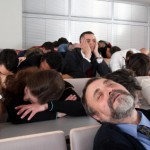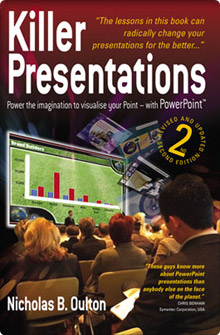
Lies, Statistics and Audience Recall
A friend e-mailed me last week with this great article for adult learning professionals (instructional design). I encourage you to read it, but the gist is that the following data are lies:
People recall:
- 10% of that they hear
- 20% of what they read
- 30% of what they see
My friend was concerned that I refer to these stats in my book and corporate website. More specifically, “On average, bullet-point slides yield a 15-20% recall of information after just five minutes.”
While I am not about to make ANY academic claims, I routinely do two tests with clients – one during the sales process and one during the training course.
The Training Course Test
When training presenters, I always give an active listening test. I play five minutes of audio and then test their recall of the information 30 minutes later. Guess what? There is an average recall rate of 15-20%, with some remembering nothing and a few outliers at 55%. Never had anyone get higher than 60%.
Which convinces me of the following:
- Most people do not actively listen
- When they do, their recall of information is poor
- Interest levels affect the levels of recall as does note taking
- Mind Map note takers do better then linear note takers
- Active Listening improves with practice
- Active Listening is a life skill not just a sales skill
The Sales Effectiveness Test
I show people four slides with the same five bullet points on them and then a diagrammatic version of the same information. About five minutes later, I ask them to recall four of the five bullet points. Generally they can recall one or two – recall varies from 10% to 50%.
The test relies on the fact that the audience isn’t really paying attention to the bullet points, hence the low recall. I then test recall on the diagram and narrative. This never fails to demonstrate that Visual Cognitive Dissonance™ increases the audience attention and produces over 90% recall of the diagram, 80% recall of the information sequence and 75% recall of the verbal information (from the presenter!) that accompanies the diagram.
Which has convinced me of the following:
- People recall nothing if they’re not paying attention
- To get people to recall anything they must first be paying attention.
- Therefore spoken words that are not heard, written words that are not read and pictures that are not studied cannot be recalled.
Now logically the first trick is to get and hold the audience’s attention – through storytelling, relevance and repetition. I call these Passive Mnemonic Processes™, designed to allow us to select the information we want the audience to recall.
Conclusions
People don’t actively listen and unless they are interested in the material, or are motivated to do so. Even more depressing is that, when they do actively listen and know there’s going to be a test, they still don’t get it all. Even if you repeat it (the old “tell them tell, them tell them” etc) it’s still poor. They have to actually process the information for it to be recalled later. I believe there are some essential steps to this:
- They have to comprehend AND understand it (not sure these are the same)
- They have to see relevance to it (or at least be interested in it)
- They have to be allowed the mental processing power to actually process it
Simply making sure the audience pays attention isn’t enough. People recall more information if it is presented to them visually with a narrative explanation that either verbally or visually alone.
I am not an academic; I am a sales person and a trainer of sales people. Our business works because we write, design and produce presentations that treble and in some cases quadruple audience recall. It’s not academic research, but practical experience and it works, consistently, repeatable and reliably.
- 10-15% recall of bullet points 5 mins after presentation is a fact.
- 80% recall of an incomplete, diagram with a narrative explanation showing relevance 5 mins after is also a fact.
Please, please, please comment and respond; this is subject close to my heart, my business and my life and I have been searching for better data for 12 years. Do you actively incorporate techniques to help your audience encode and recall the message you are delivering?

Comments
Briefly, yes. I do. And my technique is pretty much what you describe above – I try to leave things half-baked. I call it wabi-sabi and I gave a presentation at Technical Communications UK 2010 about it last week.
http://www.slideshare.net/simonbostock/wabisabi-and-elearning
(The deck perhaps doesn’t make much sense on its own so I’ll try to blog something a little later.)
I’m also fond of the idea that beauty is mnemonic. We recall ideas that are elegant. But I think you’ve hit upon the right idea – an incomplete diagram makes people work, which promotes recall.
Simon, thanks for commenting. I love the idea that Beauty is Mnemonic. I remember a maths lecturer at university showing us two different proofs, one complicated and messy and one simple and elegant. We all recalled the elegant solution. Simplicity and Symmetry both seem to me to be two core elements of Beauty that are seductive.
I love your slides, I really like the fact they don’t make sense without you.. Perfect. I look forward to your blog about them.
All the best
Nick
You might like this on elegance and incompleteness:
http://socialgamestudies.org/post/1265112968/mindcraft-or-farmville-and-minecraft-between
Nicholas, I am very interested in this topic. As a guy who hosts educational marketing events all over the U.S. soon to launch a new event called DemandCon I am always trying to find information that will help my presenters be more effective.
We should talk because I’d like to have a program at http://www.DemandCon.com on this topic or info that includes info on how to create a powerful and effective presentation that prospects will remember.
Shawn Elledge
913-962-1016